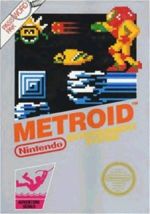Metroid (game)

| |
| Metroid | |
| Developer | Nintendo R&D1 |
| Publisher | Nintendo |
| System | NES, Game Boy Advance, Virtual Console, 3DS Virtual Console, Wii U Virtual Console |
| Release Date | NES JP August 6, 1986 US August 1987 EU January 15, 1988 Game Boy Advance JP August 10, 2004 US October 25, 2004 EU January 1, 2005 Virtual Console EU/AU July 20, 2007 US August 13, 2007 JP March 4, 2008 3DS Virtual Console JP February 29, 2012 US March 1, 2012 EU/AU March 15, 2012 Wii U Virtual Console US/EU July 11, 2013 JP August 14, 2013 |
| Genre | Action/Platformer |
| Gallery | GH Gallery |
| Rating | E |
Metroid is the game that acts as the foundation of the Metroid series. Due to the legacy this game has created, it has been ported several times and even received a completely rebuilt remake in the form of Metroid Zero Mission. The game is notable for being the only Metroid title without the ability to save and establishing many mainstays of the genre, including the basic gameplay.
Story
The Galactic Federation emerged in the year 2000 of the Cosmic Calendar. On an uncharted planet, researchers discover a new lifeform called Metroids. Before these researchers get far, the Space Pirates attack and steal the Metroids. Only one person is fit to take on this mission, a mysterious bounty hunter named Samus Aran. It is up to Samus to infiltrate the Space Pirate headquarters on the Planet Zebes to destroy the Metroids and defeat the Mother Brain in charge of it all. She first has to make her way through the planet's various areas and take on enemies such as the monsters Kraid and Ridley.
Gameplay
Metroid is a platformer that encourages free-roaming exploration. The player controls Samus in exploring the tunnels of an alien planet. The main weapon is Samus's arm cannon, which can be used to blast enemies. Various new upgrades are obtained throughout the game, some of which improve Samus's mobility while others simply enhance her weapons. The first and most emblematic power-up is the Morph Ball, which allows Samus to curl up into a small ball that can roll through narrow spaces. This is accompanied by another useful item called the bomb which can break open some paths and also can be used for the "bomb jump" trick to find out-of-reach areas. The expansive map is filled with various hidden paths and other secrets for the players to find. These hidden energy tanks which enhance Samus's health and missile tanks which increase her missile capacity.
The game was released a month after The Legend of Zelda, but did not boast the same save function. Like Kid Icarus, it used passwords as a means of saving progress in the game.
Legacy
The game was originally released on the Famicom Disk System in Japan. The game met with little popularity until released in America, when it became much more successful. This wound up forming the foundation of the Metroid series.
Ports and Remakes
- The game has received many ports over time. It was first included as an extra on Metroid Prime. The game had to be connected to Metroid Fusion to allow the game to appear.
- The game Metroid Zero Mission was a remake of the original Metroid, but featured the original game as an unlockable as well.
- Nintendo also released Metroid as a stand alone game in the "Classic NES Series" on the Game Boy Advance.
- Metroid was released for download over the Virtual Console in 2007 in North America, Europe and Australia, and in Japan in early 2008. The American release was timed to lead up to the August 28th release date of Metroid Prime 3: Corruption.
- In August 2011, Metroid was among the NES games offered as free downloads for participants in the 3DS's Ambassador Program. It later received a standard release through the eShop in early 2012, and it was also released for the Wii U Virtual Console in 2013.
Sequels
It was followed by Metroid II: The Return of Samus, which briefly brought the series to the Game Boy. Chronologically, Metroid Prime and its sequels would happen next.
Trivia
- Samus's gender was a surprise during the original release of the game. The American instruction manual retained the surprise by referring to Samus with male pronouns. Samus's gender would be revealed at the end of the game if the player performed well enough (in terms of item collection and how quickly the game was beaten), with these endings featuring Samus removing her helmet or her entire suit (revealing a bikini underneath).
- Kid Icarus used the same engine as Metroid, so as a result it is often considered a sister series.
- On the Famicom Disk System, Metroid featured battery back up saves as opposed to the password system as well as enhanced FM Synth sound.
See Also
| Titles in the Metroid Series |
|---|
| Metroid (Zero Mission) - Return of Samus (3DS) - Super Metroid - Other M - Fusion Metroid Prime - Pinball - Echoes - Hunters - Corruption - Federation Force - 4 Metroid Dread |